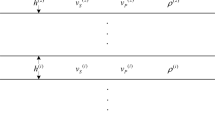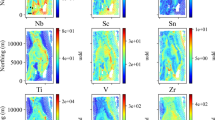Abstract
This research paper presents a comprehensive investigation into the untapped geothermal potential of Egypt’s Central Eastern Desert, highlighting its viability as a promising contender in the pursuit of sustainable energy resources. Through a rigorous multi-disciplinary approach, we systematically assess the feasibility of deploying geothermal energy in the region, supported by meticulous analysis of diverse data sources, including aeromagnetic and radiometric datasets. Our study identifies two primary sources of heat flow energy: granitic rocks enriched with radioactive minerals and dynamic geological motions. By using techniques such as derivative analysis, power spectra analysis, and heat flow calculations, we evaluate the geothermal potential using aeromagnetic data. The tilted derivative operator enables the detection of geological structures, while Curie depth points (CDPs) provide insights into the geothermal gradient and heat flow maps, revealing the distribution of subsurface heat. Surface heat flow calculations further assess the energy generation potential. Additionally, our analysis incorporates methods to estimate radioactive heat production within geological formations, considering uranium, thorium, and potassium isotopes. The ratios of potassium to thorium and uranium to thorium serve as indicators of hydrothermal alteration zones. The research findings reveal a wide range of heat flow values within the depths of the Curie depth point (CDP), ranging from 200 to 700 W/m2. At the surface, observed heat flow values range from 6 to 22 mW/m2, although relatively lower in magnitude, still hold significant potential for energy production. It is important to acknowledge the contribution of radioactive minerals, as the heat production from these sources ranges from 0 to 35 W/m3. Collectively, these heat sources present viable opportunities for energy extraction, particularly in the area between Safaga and Qusier and the area south of Qusier to Marsa Allam. Surface heat flow and radioactive heat production offer promising prospects for sustainable energy generation.










Similar content being viewed by others
Data availability
The data that supports the findings of this study is available from the corresponding author upon reasonable request.
Abbreviations
- CAL:
-
Central African Lineament
- CDP:
-
Curie depth point
- HF:
-
Heat flow
- RHP:
-
Radioactive heat production
- TAL:
-
Trans African Lineament
- TG:
-
Thermal gradient
- TMI:
-
Total magnetic intensity
- RTP:
-
Reduction to the magnetic pole
- SHF:
-
Surface heat flow
References
Abdel ZM, Saibi H, El Nouby M, Ehara S (2011) A preliminary regional geothermal assessment of the Gulf of Suez Egypt. J Afr Earth Sci 60(3):117–132
Abdel ZM, Saibi H, Nishijima J, Fujimitsu Y, Mesbah H, Ehara S (2012) Exploration and assessment of the geothermal resources in the Hammam Faraun hot spring Sinai Peninsula, Egypt. J as Earth Sci 45:256–267
Abdel ZM, Saibi H, Mansour K, Khalil A, Soliman M (2018) Geothermal exploration using airborne gravity and magnetic data at Siwa Oasis, Western Desert Egypt. Renew Sustain Energy Rev 82(3):3824–3832
Abdel Zaher M, Saibi H, Ehara S (2008) Geophysical structures of several geothermal fields with conceptual, numerical models of the hottest spring in Egypt. Proceeding of renewable energy 2008, CD-ROM
Aero Service (1984) Final report on airborne magnetic/radiation survey in Eastern Desert, Egypt. Work completed for the egyptian general petroleum corporation (EGPC). Six volumes, Aero Service, Houston, Texas, USA
Blakely RJ, Simpson RW (1986) Approximating edges of source bodies from magnetic or gravity anomalies. Geophysics 51(7):1494–1498. https://doi.org/10.1190/1.1442057
Boulos F (1989) Geothermal development of hammam faraun hot spring, Sinai-Egypt. In: international conference on applications of solar and renewable energy
Boulos F (1990) Some aspects of the geophysical regime of Egypt in relation to heat flow, ground water, and microearthquakes [Chapter 6], In Said R. The geology of Egypt, Routledge, London, 61–89
Browne PR, Lawless JV, Christie RW (1990) Geology and geothermal resources of the Wairakei-Taupo volcanic zone, New Zealand. New Zealand Geological Survey Bulletin, 107
Chandrasekharam D, Lashin A, Al Arifi N, Al Bassam A, Varun C, Singh HK (2016) Geothermal energy potential of the eastern desert region. Egypt Environ Earth Sci 75(8):697. https://doi.org/10.1007/s12665-016-5534-4
Elbarbary MA, Zaher H, Mesbah A, El-Shahat AE (2018) Curie point depth, heat flow 525 and geothermal gradient maps of Egypt deduced from aeromagnetic data. Renew Sustain Energy Rev 91:620–629
El-Sayed RAM, Assran HM, Elatta SAA (2014) Petrographic, radiometric and paleomagnetic studies for some alkaline rocks, south Nusab El Balgum mass complex, south-western Egypt. Geomaterials 4:27–46
El-Sayed E, El-Fakharani A, Zahran H, El-Nady O (2021) Geochemistry, petrography, and tectonic setting of the metasedimentary rocks from the Central Eastern Desert. Egypt J Afr Earth Sci 173:104103
Emam A, Moghazy NM, El-Sherif AM (2011) Geochemistry, petrogenesis and radioactivity of el Hudi I-type younger granites, South Eastern Desert. Egypt Arab J Geosci 4:863–878. https://doi.org/10.1007/s12517-009-0108-3
Gaafar I (2014) Geophysical mapping, geochemical evidence and mineralogy for Nuweibi rare metal albite Granite, Eastern Desert. Egypt Open J Geol 04(4):108–136. https://doi.org/10.4236/ojg.2014.44010
GSE Geological Survey of Egypt. Geologic map of Egypt. Scale 1(2), 000,000; 1981
Hinze WJ, Von Frese RRB, Saad AH (2013) Gravity and magnetic exploration principles, practices, and applications. Cambridge University Press, New York
Hsieh H, Chen C, Lin P, Yen H (2014) Curie point depth from spectral analysis of magnetic data in Taiwan. J Asian Earth Sci 90:26–33. https://doi.org/10.1016/j.jseaes.2014.04.007
Huang J, Chen Y, Sun Z, Zhang J, Gong J (2019) Geochemical and thermal constraints on the origin of the South China Sea basalts: a review. J Asian Earth Sci 173:218–238
Jiménez-Muñoz JC, Sobrino JA, Skoković D (2014) A generalized split-window algorithm for retrieving land-surface temperature from space. IEEE Trans Geosci Remote Sens 52(6):3815–3824
Li ZL, Tang BH, Wu H, Ren H, Yan G, Wan Z, Weng F (2013) Satellite-derived land surface temperature: current status and perspectives. Remote Sens Environ 131:14–37
Li X, Zhang Y, Wang H, Li T (2015) Application of tilted derivative operator to delineate magnetic basement structures in the North Yellow Sea basin. J Geophys Eng 12(5):815–823. https://doi.org/10.1088/1742-2132/12/5/815
Lundmark AM, Andresen A, Hassan MA, Augland LE, Boghdady GY (2012) Repeated magmatic pulses in the East African Orogen in the Eastern Desert, Egypt: an old idea supported by new evidence. Gondwana Res 22(1):227–237. https://doi.org/10.1016/j.gr.2011.08.017
Maden N (2010) Curie-point depth from spectral analysis of magnetic data in Erciyes Stratovolcano (central Turkey). Pure Appl Geophys 167(3):349–358. https://doi.org/10.1007/s00024-009-0017-0
Mohamed HS, Abdel Zaher M, Senosy MM, Saibi H, El Nouby M, Fairhead JD (2015) Correlation of aerogravity and BHT data to develop a geothermal gradient map of the Northern Western Desert of Egypt using an artificial neural network. Pure Appl Geophys 172:1585–1597. https://doi.org/10.1007/s00024-014-0998-1
Mohamed, A.Z., Ehara, S., Saibi H. (2008) Conceptual and numerical modeling of hammam faraun hot spring, Sinai Peninsula, Egypt. Oral presentation at 2008 Annual Meeting Geothermal Research Society of Japan, October, Japan
Morgan P, Boulos FK, Swanberg CA (1983) Regional geothermal exploration in Egypt. Geophys Prospect 31(2):361–376. https://doi.org/10.1111/j.1365-2478.1983.tb01059.x
Morgan P, Boulos FK, Hennin SF, El-Sherif AA, El-Sayed AA, Basta NZ et al (1985) Heat flow in Eastern Egypt: the thermal signature of a continental breakup. J Geodyn 4(1–4):107–131. https://doi.org/10.1016/0264-3707(85)90055-9
Okubo Y, Graf RJ, Hansen RO, Ogawa K, Tsu H (1985) Curie point depths of the island of Kyushu and surrounding areas. Japan Geophys 50(3):481–494. https://doi.org/10.1190/1.1441926
Parry SJ, Hodson KR, Barron AJ (2010) Geology and thermal characteristics of the Taupo Volcanic Zone. New Zealand: a Rev Geotherm 39(3):239–254
Perrin M, Saleh A, Alva-Valdivia L (2009) Cenozoic and Mesozoic basalt from Egypt: a preliminary survey. Earth Planets Sp 61:51–60. https://doi.org/10.1186/BF03352884
Raslan MF, El-Feky MG (2012) Radioactivity and mineralogy of the altered granites of the Wadi Ghadir shear zone, South Eastern Desert. Egypt Chin J Geochem 31(1):30–40. https://doi.org/10.1007/s11631-012-0546-6
Refaat MM, Karameldin A, Abdel-Fattah AA (2016) Geochemical and geophysical investigations of geothermal potential in the Red Sea region. Egypt J Afr Earth Sci 120:1–15. https://doi.org/10.1016/j.jafrearsci.2016.03.016
Riquelme R, Montalvo S, Pizarro J, Jara P, Parada MA (2021) Evaluation of geothermal potential in the Andean volcanic belt in Chile using uranium and thorium concentration ratios. Energies 14(3):729
Saha D, Sain K, Deb M (2021) Estimation of geothermal resources and heat flow in the Himalayan region using the Curie depth method. J Earth Syst Sci 130(4):1–15
Saleh S, Salk M, Pamukçu O (2013) Estimating Curie point depth and heat flow Map for northern Red Sea rift of Egypt and its surroundings, from aeromagnetic data. Pure Appl Geophys 170(5):863–885. https://doi.org/10.1007/s00024-012-0461-0
Saleh GM, Salem IA, Darwish M, Mostafa DA (2014) Gabal El Faliq granitoid rocks of the southeastern Desert, Egypt: geochemical constraints, mineralization and spectrometric prospecting. World Earth Planet Sci 1–1:1–22
Salem A, Williams S, Fairhead D, Smith R, Ravat D (2008) Interpretation of magnetic data using tilt-angle derivatives. Geophysics 73:L1–L10
Salem, Ahmed & Green, Chris & Ravat, Dhananjay & Singh, K H & East, Paul & Fairhead, James & Mogren, Saad & Biegert, Ed. (2014) Depth to curie temperature across the central red sea from magnetic data using the de-fractal method. Tectonophysics. 624-625. https://doi.org/10.1016/j.tecto.2014.04.027
Salem A, Ushijima K, Elsirafi A, Mizunaga H. (2000) Spectral analysis of aeromagnetic data for geothermal reconnaissance of Quseir area, northern Red Sea, Egypt. In: Proceedings of the world geothermal congress. 16691674, 1669–74
Shuey RT, Schellinger DK, Tripp AC, Alley LB (1977) Curie depth determination from aeromagnetic spectra. Geophys J Int 50(1):75–101. https://doi.org/10.1111/j.1365-246X.1977.tb01325.x
Stampolidis A, Kane I, Tsokas GN, Tsourlos P (2005) Curie point depths of Albania inferred from ground total field magnetic data. Surv Geophys 26(4):461–480. https://doi.org/10.1007/s10712-005-7886-2
Stern RJ (1985) The Najd Fault System, Saudi Arabia and Egypt: a Late Precambrian rift-related transform system? Tectonics 4(5):497–511. https://doi.org/10.1029/TC004i005p00497
Stern RJ, Johnson P (2010) Continental lithosphere of the Arabian Plate: a geologic, petrologic, and geophysical synthesis. Earth Sci Rev 101(1–2):29–67. https://doi.org/10.1016/j.earscirev.2010.01.002
Tanaka A, Okubo Y, Matsubayashi O (1999) Curie point depth based on spectrum analysis of the magnetic anomaly data in East and Southeast Asia. Tectonophysics 306(3–4):461–470. https://doi.org/10.1016/S0040-1951(99)00072-4
Tselentis G (1991) An attempt to define Curie point depths in Greece from aeromagnetic and heat flow data. Pageoph 136(1):87–101. https://doi.org/10.1007/BF00878889
Turcotte DL, Schubert G (1982) Geodynamics. Cambridge University Press, New York
Zhang XX, Li JY, Yuan JH (2019) Mapping hydrothermal alteration zones by integrating ASTER data and geochemical data in the Tengchong volcanic field, SW China. J Geochem Explor 203:13–25
Funding
This research was supported by the Academy of Scientific Research and Technology under the funded project with the title “Geothermal Resource Assessment of the Red Sea by Geophysical Modeling.”
Author information
Authors and Affiliations
Contributions
Gaber M. Gaber played a critical role in the research process by contributing to the design and implementation of the study, analyzing the results, and assisting in the writing of the manuscript. His valuable insights and expertise were instrumental in the success of this project. Salah Saleh and Adel Kotb provided invaluable guidance and oversight throughout the study. Their extensive knowledge and experience in the field ensured that the research was conducted to the highest standards and that the results were accurate and reliable. Their supervision was crucial in ensuring the successful completion of this project.
Corresponding author
Ethics declarations
Conflict of interest
The authors declare that they have no known competing financial interests or personal relationships that could have appeared to influence the work reported in this paper.
Additional information
Edited by Prof. Sanjit Kumar Pal (ASSOCIATE EDITOR) / Prof. Gabriela Fernández Viejo (CO-EDITOR-IN-CHIEF).
Supplementary Information
Below is the link to the electronic supplementary material.
Rights and permissions
Springer Nature or its licensor (e.g. a society or other partner) holds exclusive rights to this article under a publishing agreement with the author(s) or other rightsholder(s); author self-archiving of the accepted manuscript version of this article is solely governed by the terms of such publishing agreement and applicable law.
About this article
Cite this article
Gaber, G.M., Saleh, S. & Kotb, A. Integrating radiometric and aeromagnetic data for assessment of geothermal potential: a case study in Central Eastern Desert, Egypt. Acta Geophys. (2024). https://doi.org/10.1007/s11600-024-01370-y
Received:
Accepted:
Published:
DOI: https://doi.org/10.1007/s11600-024-01370-y




